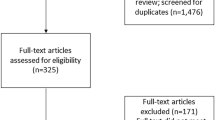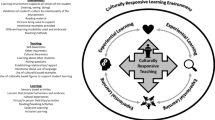Abstract
Medical education has a role to play in responding to the global call for social justice. Medical educators can lead the global transformation by adopting culturally responsive teaching (CRT) practices. The ultimate objective must be the achievement of equitable learning and success outcomes for all students, especially those from underrepresented and international communities. The strategies outlined in this paper offer specific, actionable, evidence-based strategies that will empower educators to apply the CRT framework within the course design, delivery, and evaluation. As a result, more inclusive classroom environments will be created, ultimately closing the outcome gaps that exist between students.
Similar content being viewed by others
References
Ambrose SA, Bridges MW, DiPietro M, Lovett MC, Norman MK, Mayer RE. How learning works: seven research-based principles for smart teaching. 1st ed. San Francisco, CA: John Wiley & Sons, Inc.; 2010.
Kleinfeld JS. Effects of nonverbal warmth on the learning of Eskimo and White students. J S Psychol. Routledge; 1974;92:3–9.
Ladson-Billings G. The dreamkeepers. Successful teachers of African American children. 1st ed. San Francisco, CA: Jossey-Bass Inc; 1994.
Wlodkowski RJ, Ginsberg MB. Diversity & motivation: Culturally responsive teaching. Jossey-Bass Higher and Adult Education Series. Jossey-Bass Education Series, Jossey-Bass Social and Behavioral Science Series. 1st ed. San Francisco, CA: Jossey-Bass Inc; 1995.
Gay G. Preparing for culturally responsive teaching. J Teach Educ. SAGE Publications Inc; 2002;53:106–16.
Fink LD. Creating significant learning experiences: an integrated approach to designing college courses. John Wiley & Sons; 2003.
Fink LD. A self-directed guide to designing courses for significant learning [Internet]. Dee Fink and Associates: Designing Courses for Significant Learning. 2020 [cited 23 Aug 2020]. Available from: https://www.deefinkandassociates.com/GuidetoCourseDesignAug05.pdf.
Tanner KD. Structure matters: Twenty-one teaching strategies to promote student engagement and cultivate classroom equity. CBE Life Sci Educ. 2013;12:322–31.
Sue DW. Microaggressions in everyday life: Race, gender, and sexual orientation. Wiley. 1st ed. Hoboken, NJ: John Wiley & Son Ltd; 2010.
Blumberg P. Assessing and improving your teaching: strategies and rubrics for faculty growth and student learning. 1st ed. San Francisco: Jossey-Bass; 2013.
Verschelden C, Pasquerella L. Bandwidth recovery: helping students reclaim cognitive resources lost to poverty, racism, and social marginalization. Illustrated. Sterling, Virginia: Stylus Publishing; 2017.
Nieblas-Bedolla E, Christophers B, Nkinsi NT, Schumann PD, Stein E. Changing how race is portrayed in medical education: Recommendations from medical students. Acad Med. 2020; Publish Ahead of Print.
Preiser WFE, Smith KH, editors. Universal design handbook [Internet]. 2nd ed. USA: McGraw-Hill Professional; 2011. Available from: https://www.mhprofessional.com/9780071629232-usa-universal-design-handbook-2e-group.
Steele CM, Aronson J. Stereotype threat and the intellectual test performance of African Americans. J Pers Soc Psychol. 1995;69:797–811.
Clance PR, Imes SA. The imposter phenomenon in high achieving women: Dynamics and therapeutic intervention. Psychotherapy: Theory, Research & Practice. US: Division of Psychotherapy (29), American Psychological Association; 1978;15:241–7.
Walton GM, Cohen GL. A brief social-belonging intervention improves academic and health outcomes of minority students. Science. American Association for the Advancement of Science; 2011;331:1447–51.
Winkelmes. Transparency in learning and teaching project [Internet]. Transparency in Learning and Teaching Project. 2014 [cited 29 Aug 2020]. Available from: https://tilthighered.com/transparency.
Johnson DR, Alvarez P, Longerbeam S, Soldner M, Inkelas KK, Leonard JB, et al. Examining sense of belonging among first-year undergraduates from different racial/ethnic groups. J Coll Stud Dev. Johns Hopkins University Press; 2007;48:525–42.
Harden R, Laidlaw J. Essential skills for a medical teacher-2nd edition. 2nd ed. Edinburgh: Elsevier; 2016.
Conzemius A, O’Neill J. The power of SMART goals: using goals to improve student learning. Bloomington, IN: Solution Tree Press; 2009.
Anderson LW, Krathwohl DR, Airasian PW, Cruikshank KA, Mayer RE, Pintrich PR, et al. A taxonomy for learning, teaching, and assessing: a revision of Bloom’s taxonomy of educational objectives, Abridged Edition. 1st ed. New York, NY: Pearson; 2001.
Miller GE. The assessment of clinical skills/competence/performance. Acad Med. 1990;65:S63.
Paas F, Renkl A, Sweller J. Cognitive load theory and instructional design: Recent developments. Educ Psychol. Routledge; 2003;38:1–4.
Kuh GD, Schneider CG. High-impact educational practices: what they are, who has access to them, and why they matter. Washington, DC: Association of American Colleges and Universities; 2008.
Buckley S, Coleman J, Davison I, Khan KS, Zamora J, Malick S, et al. The educational effects of portfolios on undergraduate student learning: a best evidence medical education (BEME) systematic review. BEME Guide No. 11. Medical Teacher. Taylor & Francis; 2009;31:282–98.
Ogle DM. K-W-L: A teaching model that develops active reading of expository text. Read Teach. 1986;39:564–70.
Wormald BW, Schoeman S, Somasunderam A, Penn M. Assessment drives learning: An unavoidable truth? Anat Sci Educ. 2009;2:199–204.
Green GP, Bean JC, Peterson DJ. Deep learning in intermediate microeconomics: Using scaffolding assignments to teach theory and promote transfer. J Econ Educ. Routledge; 2013;44:142–57.
Tonelli MR, Upshur REG. A philosophical approach to addressing uncertainty in medical education. Acad Med. 2019;94:507–11.
Rutledge A. 23 Embeddable Ed Tech tools for MedEd | DaVinci Education [Internet]. 2020 [cited 30 Aug 2020]. Available from: https://www.davinci-ed.com/resources/23-embeddable-ed-tech-tools-for-meded.
Hattie J, Timperley H. The power of feedback. Rev Educ Res. American Educational Research Association; 2007;77:81–112.
Dweck CS. Mindset: The new psychology of success. New York, NY, US: Random House; 2006. p. x, 276.
Boyd DE. The growth mindset approach: a threshold concept in course redesign. 1 [Internet]. 2014 [cited 30 Aug 2020];6. Available from: https://openjournal.lib.miamioh.edu/index.php/jctl/article/view/139.
Author information
Authors and Affiliations
Corresponding author
Ethics declarations
Ethics Approval
N/A.
Informed Consent
N/A.
Conflict of Interest
The authors declare no competing interests.
Additional information
Publisher's Note
Springer Nature remains neutral with regard to jurisdictional claims in published maps and institutional affiliations.
Rights and permissions
About this article
Cite this article
Weiler, T., Caton, E. Evidence-Based Practices for Culturally Responsive Medical Education. Med.Sci.Educ. 31, 2199–2207 (2021). https://doi.org/10.1007/s40670-021-01440-6
Accepted:
Published:
Issue Date:
DOI: https://doi.org/10.1007/s40670-021-01440-6




